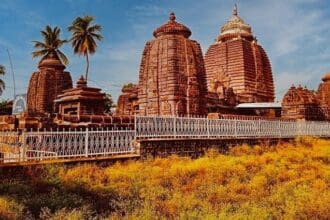Horsley Hills, nestled in the serene landscapes of Andhra Pradesh, is a haven for travelers seeking tranquility, natural beauty, and cultural richness. Known as the “Ooty of Andhra,” this picturesque hill station offers breathtaking views, lush greenery, and an array of attractions that captivate visitors from all walks of life. In this article, we delve deep into the top 5 places to visit in Horsley Hills , providing you with an immersive guide to explore its hidden gems and iconic landmarks.
1. The Enchanting Mallamma Temple: A Spiritual Retreat
The Mallamma Temple stands as one of the most revered and spiritually significant sites in Horsley Hills. This ancient temple, dedicated to Goddess Mallamma, draws devotees and tourists alike who seek blessings and solace amidst the tranquil surroundings.
Historical Significance
The origins of the Mallamma Temple can be traced back centuries, making it a cornerstone of local culture and spirituality. According to folklore, Goddess Mallamma is believed to protect the region from evil forces, earning her a revered status among the locals. Pilgrims often recount stories of miraculous interventions attributed to the deity, further solidifying her importance in the hearts of believers.
The temple’s architecture reflects traditional South Indian craftsmanship, characterized by intricate carvings and vibrant frescoes. Every pillar and wall tells a story, depicting scenes from Hindu mythology such as the churning of the ocean (Samudra Manthan) and the victory of good over evil (Durga slaying Mahishasura). These artistic elements not only enhance the aesthetic appeal but also serve as educational tools for younger generations.
Architectural Marvels
Visitors are often mesmerized by the temple’s stone carvings and vibrant frescoes depicting scenes from Hindu mythology. The sanctum sanctorum houses the idol of Goddess Mallamma, which is adorned with exquisite jewelry during festivals. The temple’s serene ambiance is further enhanced by the surrounding lush forests, creating a perfect setting for meditation and introspection.
The temple complex includes several smaller shrines dedicated to other deities such as Lord Shiva, Vishnu, and Hanuman. Each shrine has its own unique design and significance, offering devotees multiple avenues for prayer and reflection. The main hall, or mandapam, is supported by intricately carved pillars that showcase the skill and dedication of ancient artisans.
Festivals and Celebrations
The annual Mallamma Jathara is a grand festival celebrated with immense fervor. Devotees from neighboring towns and villages gather to participate in processions, rituals, and cultural performances. The air is filled with the aroma of incense, the sound of devotional hymns, and the vibrant colors of traditional attire, making it a truly unforgettable experience.
During the festival, the temple premises come alive with stalls selling traditional snacks, handicrafts, and religious artifacts. Cultural programs featuring classical dance and music performances add to the festive spirit. For many, the Mallamma Jathara is not just a religious event but a celebration of community and heritage.
“The Mallamma Temple is not just a place of worship; it is a sanctuary where spirituality meets nature.”
2. Gali Banda Viewpoint: A Panoramic Paradise
Perched atop the hills, the Gali Banda Viewpoint offers unparalleled vistas of the surrounding valleys and plains. It is a must-visit destination for nature enthusiasts, photographers, and adventure seekers.
Scenic Beauty
As you ascend to the viewpoint, you’ll be greeted by a carpet of verdant greenery stretching as far as the eye can see. The cool breeze and the melodious chirping of birds create a soothing atmosphere, making it an ideal spot for relaxation. During sunrise and sunset, the sky transforms into a canvas of vibrant hues, casting a golden glow over the landscape.
The viewpoint provides a 360-degree panoramic view, allowing visitors to take in the vast expanse of rolling hills, dense forests, and distant villages. On clear days, you can even spot the shimmering waters of nearby lakes and rivers, adding to the visual splendor.
Photography Opportunities
For photography enthusiasts, the Gali Banda Viewpoint is a dream come true. The interplay of light and shadow, coupled with the dramatic topography, provides endless opportunities to capture stunning images. Whether you’re an amateur photographer or a seasoned professional, this location promises to inspire your creativity.
Golden hour, which occurs shortly after sunrise and before sunset, is particularly magical at the viewpoint. The soft, diffused light enhances the natural colors of the landscape, creating postcard-perfect scenes. Many photographers also experiment with long-exposure techniques to capture the movement of clouds and the twinkling lights of distant settlements at night.
Adventure Activities
Thrill-seekers can indulge in activities such as trekking and paragliding near the viewpoint. The rugged terrain and steep slopes offer a challenging yet rewarding experience for adventurers. Guided treks are available for those who wish to explore the area while learning about its flora and fauna.
Paragliding, in particular, has gained popularity among adrenaline junkies. Launching from the viewpoint, participants soar above the hills, experiencing a bird’s-eye view of the breathtaking scenery below. Safety measures are strictly enforced, ensuring a thrilling yet secure experience.
3. Environmental Park: A Green Oasis
The Environmental Park in Horsley Hills is a testament to the region’s commitment to preserving its natural heritage. This sprawling park is a hub of biodiversity, featuring a wide variety of plant species, walking trails, and recreational facilities.
Flora and Fauna
The park is home to numerous indigenous trees, shrubs, and flowering plants, many of which are rare and endangered. Visitors can stroll along the well-maintained pathways, observing the vibrant ecosystem up close. Birdwatchers will delight in spotting exotic avian species such as the Malabar Parakeet and the Indian Pitta.
Some of the notable plant species found in the park include the Red Sandalwood, Neem, and Teak trees. These trees not only contribute to the park’s lush greenery but also play a crucial role in maintaining ecological balance. Interpretive signage throughout the park provides information about each species, enhancing visitors’ understanding of the local flora.
Recreational Facilities
For families and groups, the Environmental Park offers picnic spots, children’s play areas, and open spaces for outdoor games. The serene ponds within the park provide a peaceful setting for reflection and relaxation. Additionally, educational programs and workshops on environmental conservation are conducted regularly, making it an ideal destination for eco-conscious travelers.
Children can enjoy swings, slides, and jungle gyms in designated play areas, while adults can unwind on benches overlooking the ponds. The park’s amphitheater hosts occasional events, including storytelling sessions and nature-themed movie screenings.
Sustainability Initiatives
The park plays a crucial role in promoting sustainable tourism practices. Efforts such as waste management, water conservation, and afforestation projects ensure that the park remains a pristine environment for future generations to enjoy.
Recycling bins are strategically placed throughout the park to encourage proper disposal of waste. Rainwater harvesting systems have been installed to conserve water, while solar panels power lighting fixtures and other amenities. Community involvement is actively encouraged through volunteer programs and awareness campaigns.
4. Koundinya Wildlife Sanctuary: A Haven for Wildlife Lovers
Located near Horsley Hills, the Koundinya Wildlife Sanctuary is a treasure trove of biodiversity and a paradise for wildlife enthusiasts. Spanning over 350 square kilometers, the sanctuary is home to a diverse range of animal and bird species.
Wildlife Encounters
The sanctuary is renowned for its population of Asian elephants , which roam freely across the dense forests. Other notable inhabitants include leopards, sloth bears, spotted deer, and wild boars. Guided safaris allow visitors to witness these majestic creatures in their natural habitat while ensuring minimal disturbance to the ecosystem.
Elephants are often seen congregating near water sources, especially during the dry season. Their playful antics and social interactions provide ample opportunities for observation and photography. Leopards, though elusive, occasionally make appearances, particularly during early morning hours when they hunt for prey.
Birdwatching Delights
With over 200 species of birds documented in the sanctuary, it is a haven for ornithologists and birdwatchers. From the majestic Indian Peafowl to the elusive Malabar Trogon, the avian diversity is truly remarkable. Early morning and late afternoon are the best times to observe birds in their full splendor.
Some of the standout bird species include the Great Hornbill, Grey Junglefowl, and Paradise Flycatcher. The sanctuary’s varied habitats—ranging from dense forests to open grasslands—support a wide range of avian life. Binoculars and field guides are recommended for optimal birdwatching experiences.
Conservation Efforts
The sanctuary actively participates in conservation initiatives aimed at protecting endangered species and preserving their habitats. Community involvement and awareness programs have been instrumental in fostering a sense of responsibility among local residents.
Anti-poaching patrols, habitat restoration projects, and breeding programs for endangered species are some of the key initiatives undertaken by the sanctuary authorities. Educational tours and workshops are organized for schools and colleges to instill a love for nature in young minds.
5. Thimmamma Marrimanu: A Natural Wonder
The Thimmamma Marrimanu , located a short drive from Horsley Hills, holds the distinction of being one of the largest banyan trees in the world. This colossal tree is not only a botanical marvel but also a symbol of resilience and longevity.
Botanical Significance
Spread across five acres, the Thimmamma Marrimanu boasts a canopy so vast that it creates a microclimate beneath its branches. The tree’s aerial roots form a labyrinthine network, providing shelter to countless organisms. Its sheer size and age—estimated to be over 600 years old—make it a subject of fascination for botanists and researchers.
The tree’s massive trunk and sprawling branches support a thriving ecosystem, housing insects, reptiles, and small mammals. Seasonal changes bring about shifts in the tree’s appearance, with new leaves sprouting in spring and shedding in autumn. Scientists study the tree’s growth patterns and adaptations to better understand its longevity.
Cultural Importance
According to local legend, the tree was planted in memory of Thimmamma, a devoted wife who sacrificed her life for her husband’s well-being. The site is considered sacred, and pilgrims often visit to pay their respects and seek blessings. Annual fairs and cultural events are organized under the tree’s expansive shade, drawing large crowds.
The tree serves as a backdrop for various ceremonies, including weddings and naming rituals. Elders share stories of Thimmamma’s devotion, passing down oral traditions from generation to generation. The tree’s presence evokes a sense of reverence and awe, reminding visitors of the interconnectedness of nature and human life.
Visitor Experience
Exploring the Thimmamma Marrimanu is a surreal experience. Walking beneath its towering branches evokes a sense of awe and reverence. Picnic spots and seating areas are available for visitors to unwind and soak in the tranquil ambiance.
Guided tours provide insights into the tree’s history, ecology, and cultural significance. Visitors can learn about the tree’s role in local folklore and its contributions to the surrounding ecosystem. Souvenir shops sell handmade crafts and memorabilia inspired by the tree’s legacy.
Why Horsley Hills Should Be Your Next Travel Destination
Horsley Hills is more than just a hill station; it is a destination that offers something for everyone. Whether you’re seeking spiritual enlightenment, natural beauty, or adventure, this charming locale has it all. Its proximity to major cities like Bangalore and Chennai makes it easily accessible, while its unspoiled landscapes ensure a refreshing escape from urban chaos.
Accommodation Options
From luxury resorts to budget-friendly homestays, Horsley Hills caters to a wide range of preferences. Many accommodations offer panoramic views of the hills, adding to the overall charm of your stay.
Luxury resorts such as the Horsley Hills Resort and Hill Country Resorts provide world-class amenities, including spas, swimming pools, and fine-dining restaurants. Budget travelers can opt for cozy homestays run by local families, offering authentic hospitality and home-cooked meals.
Local Cuisine
No trip to Horsley Hills is complete without savoring the local delicacies. Traditional Andhra dishes such as Gongura Pachadi, Pulihora, and Pesarattu are sure to tantalize your taste buds. Street food stalls and fine-dining restaurants alike serve authentic flavors that reflect the region’s culinary heritage.
Andhra cuisine is known for its bold flavors and generous use of spices. Non-vegetarian options like Kodi Pulao (chicken biryani) and Royyalu Iguru (prawn curry) are particularly popular. Vegetarians can indulge in dishes like Avakaya (mango pickle) and Pappu Charu (lentil soup).
Frequently Asked Questions (FAQs)
- What is the best time to visit Horsley Hills?
The ideal time to visit is between October and March when the weather is pleasant and conducive for outdoor activities. - How do I reach Horsley Hills?
Horsley Hills is approximately 140 km from Bangalore and 160 km from Chennai. Regular bus services and private taxis are available. - Are there any entry fees for the attractions?
Most attractions have nominal entry fees, while some, like the Environmental Park, may charge slightly higher rates for guided tours. - Is Horsley Hills suitable for family vacations?
Absolutely! With its safe environment, kid-friendly parks, and diverse activities, it is an excellent choice for families. - Can I go trekking in Horsley Hills?
Yes, several trails cater to different skill levels, offering breathtaking views and a chance to connect with nature. - What should I pack for my trip?
Comfortable clothing, sturdy shoes, sunscreen, and a camera are essential items to carry. - Are there medical facilities nearby?
Basic healthcare services are available in Horsley Hills, with advanced facilities located in nearby towns. - Is photography allowed at all locations?
Photography is permitted at most sites, but it’s advisable to check specific rules before capturing images. - What languages are spoken in Horsley Hills?
Telugu and English are widely spoken, making communication convenient for tourists. - Are pets allowed in the parks?
Pets are generally not allowed in protected areas, but some accommodations may permit them.

















